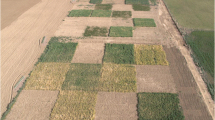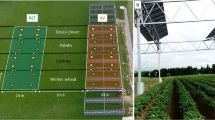Abstract
Florida citrus and vegetable crops generate billions of dollars in revenue every year. However, wind, freezing temperatures, hurricanes, and diseases negatively impact production. Windbreaks located perpendicular to the prevailing wind can increase farm production simply by reducing wind and modifying microclimate. Windbreaks can also help in managing pathogens such as citrus canker (Xanthomonas campestris pv. citri). To study the modification of wind speed, temperature, and relative humidity on the leeside of single-row tree windbreaks in southern Florida, automated weather stations were installed in 2007/2008 at 2 m above the ground along transects perpendicular to a eastern redcedar (Juniperus virginiana) and three cadaghi (Corymbia torelliana) (WB1–WB3) windbreaks. All windbreaks reduced wind speed, with minimum wind speed (~5% of the open wind speed) at two times the distance of windbreak height (2H, where H = windbreak height in m) on the leeside of a E. redcedar (~17% porosity) and at 4H (~3–30% of the open wind speed) and 6H (<50% of the open wind speed) on the leeside of cadaghi windbreaks WB1 (~22% porosity) and WB2 (~36% porosity), respectively, when the wind direction was nearly perpendicular to the windbreaks. Wind speed reduction was observed up to 31 times the windbreak height (31H). Cadaghi windbreaks reduced wind speed on the leeside even during a tropical storm event. Temperatures on the leeside of the windbreaks were warmer during the day and cooler near the windbreaks at night compared to temperature in the open fields. This study demonstrates that single-row tree windbreaks can reduce wind and modify the microclimate to enhance crop production for Florida growers.














Similar content being viewed by others
References
Albrigo LG (1976) Influence of prevailing winds and hedging on citrus fruit wind scar. Proc Fla State Hort Soc 89:55–59
Behlau F, Belasque J Jr, Bergamin-Filho A, Graham JH, Leite RP Jr, Gottwald TR (2008) Copper sprays and windbreaks for control of citrus canker on young orange trees in southern Brazil. Crop Prot 27:803–807
Brandle JR, Hodges L, Zhou XH (2004) Windbreaks in North American agricultural systems. Agrofor Syst 61:65–78
Brenner AJ, Jarvis PG, van den Beldt RJ (1995) Windbreak-crop interactions in the Sahel. 1. Dependence of shelter on field conditions. Agric For Meteorol 75:215–234
Caborn JM (1957) Shelterbelts and microclimate. Forestry commission bulletin No. 29. Edinburgh University, Edinburgh
Cleugh HA (1998) Effects of windbreaks on airflow, microclimates and crop yields. Agrofor Syst 41:55–84
Cleugh HA (2002) Field measurements of windbreak effects on airflow, turbulent exchanges and microlimates. Aust J Exp Agric 42:665–677
Cleugh HA, Hughes DE (2002) Impact of shelter on crop microclimates: a synthesis of results from wind tunnel and field experiments. Aust J Exp Agric 42:679–701
Cleugh H, Prinsley R, Bird RP, Brooks SJ, Carberry PS, Crawford MC, Jackson TT, Meinke H, Mylius SJ, Nuberg IK, Sudmeyer RA, Wright AJ (2002) The Australian national windbreaks program: overview and summary of results. Aust J Exp Agric 42:649–664
FDACS (2007) Florida agricultural statistical directory. Florida department of agriculture and consumer services (FDACS). http://www.florida-agriculture.com/pubs/pubform/pdf/Florida_Agricultural_Statistical_Directory.pdf Accessed 15 Jan 2009
Foereid B, Bro R, Mogensen VO, Porter JR (2002) Effects of windbreak strips of willow coppice-modelling and field experiment on barley in Denmark. Agric Ecosyst Environ 93:25–32
Gottwald TR, Timmer LW (1995) The efficacy of windbreaks in reducing the spread of citrus canker caused by Xanthomonas campestris pv. citri. Trop Agric 72:194–201
Graham JH, Gottwald TR, Cubero J, Achor DS (2004) Xanthomonas axonopodis pv. citri: factors affecting successful eradication of citrus canker. Mol Plant Pathol 5:1–15
Jones HK, Sudmeyer RA (2002) Economic assessment of windbreaks on the southeast coast of Western Australia. Aust J Exp Agric 42:751–762
Kenny WA (1987) A method for estimating windbreak porosity using digitized photographic silhouettes. Agric For Meteor 39:91–94
Leite RP Jr (2000) Surviving with citrus canker in Brazil. Proc Int Soc Citricult 2:890–896
Leite RP, Mohan SK (1990) Integrated management of citrus bacterial canker caused by Xanthomonas campestris pv. citri in the State of Parana, Brazil. Crop Prot 9:3–7
Loeffler AE, Gordon AM, Gillespie TJ (1992) Optical porosity and windspeed reduction by coniferous windbreaks in Southern Ontario. Agrofor Syst 17:119–133
McAneney KJ, Salinger MJ, Porteous AS, Barber RF (1990) Modifications to an orchard climate with increasing shelter height. Agric For Meteorol 50:211–227
Metcalf W (1936) The influence of windbreaks in protecting citrus orchards. J For 34:571–580
Michels K, Lamers JPA, Buerkert A (1998) Effects of windbreak species and mulching on wind erosion and millet yield in the Sahel. Expl Agric 34:464–499
Miller WM, Burns JK (1992) Grade lowering defects and grading practices for Indian River grapefruit. Proc Fla State Hort Soc 105:129–130
Miller WR, McDonald RE, Sharp JL (1990) Condition of Florida carambolas after hot-air treatment and storage. Proc Fla State Hort Soc 103:238–241
Morales P, Davies FS (2000) Pruning and skirting affect canopy microclimate, yields, and fruit quality of ‘Orlando’ tangelo. Hort Sci 35:30–35
Nuberg IK (1998) Effect of shelter on temperate crops: a review to define research for Australian conditions. Agrofor Syst 41:3–34
Núñez-Elisea R, Crane JH (2000) Selective pruning and crop removal increase early-season fruit production of carambola (Averrhoa carambola L.). Sci Hort 86:115–126
Peri PL, Bloomberg M (2002) Windbreaks in southern Patagoina, Argentina: a review of research on growth models, wind speed reduction, and effects on crops. Agrofor Syst 56:129–144
Rockwood DL, Rudie AW, Ralph SA, Zhu JY, Winandy JE (2008) Energy product options for Eucalyptus species grown as short rotation woody crops. Int J Mol Sci 9:1361–1378
Stover E, Hebb J, Sonoda R (2004) Airblast application of copper fungicide to grapefruit does not affect windscar. Hort Sci 39:516–519
Sudmeyer R, Flugge F (2005) The economics of managing tree–crop competition in windbreak and alley systems. Aust J Exp Agric 45:1403–1414
Sudmeyer RA, Scott PR (2002) Characterization of a windbreak system on the south cost of Western Australia. 1. Microclimate and wind erosion. Aust J Exp Agric 42:703–715
Sudmeyer RA, Crawford MC, Meinke H, Poulton PL, Robertson MJ (2002) Effect of artificial wind shelters on the growth and yield of rainfed crops. Aust J Exp Agric 42:841–858
Sun D, Dickinson GR (1997) Early growth of six native Australian tree species in windbreaks and their effect on potato growth in tropical northern Australia. For Ecol Manage 95:21–34
Timmer LW, Garnsey SM, Graham JH (2000) Compendium of citrus diseases. American Phytopathogical Society, St. Paul
Vigiak O, Sterk G, Warren A, Jagen LJ (2003) Spatial modeling of wind speed around windbreaks. Catena 52:273–288
Wang H, Takle ES (1995) Numerical simulations of shelterbelt effects on wind direction. J Appl Meteorol 34:2206–2219
Zhang H, Brandle JR, Meyer GE, Hodges L (1995) The relationship between open wind speed and wind speed reduction in shelter. Agrofor Syst 32:297–311
Acknowledgments
This research was financially supported by the Institute of Food and Agricultural Sciences (IFAS/UF), the College of Agriculture and Life Sciences (CALS/IFAS), and the Sustainable Agriculture Research and Education (Southern Region) Program. The authors would like to thank SFRC/UF, SWFREC/UF, and C&B Farms staff for their help during the study.
Author information
Authors and Affiliations
Corresponding author
Rights and permissions
About this article
Cite this article
Tamang, B., Andreu, M.G. & Rockwood, D.L. Microclimate patterns on the leeside of single-row tree windbreaks during different weather conditions in Florida farms: implications for improved crop production. Agroforest Syst 79, 111–122 (2010). https://doi.org/10.1007/s10457-010-9280-4
Received:
Accepted:
Published:
Issue Date:
DOI: https://doi.org/10.1007/s10457-010-9280-4




